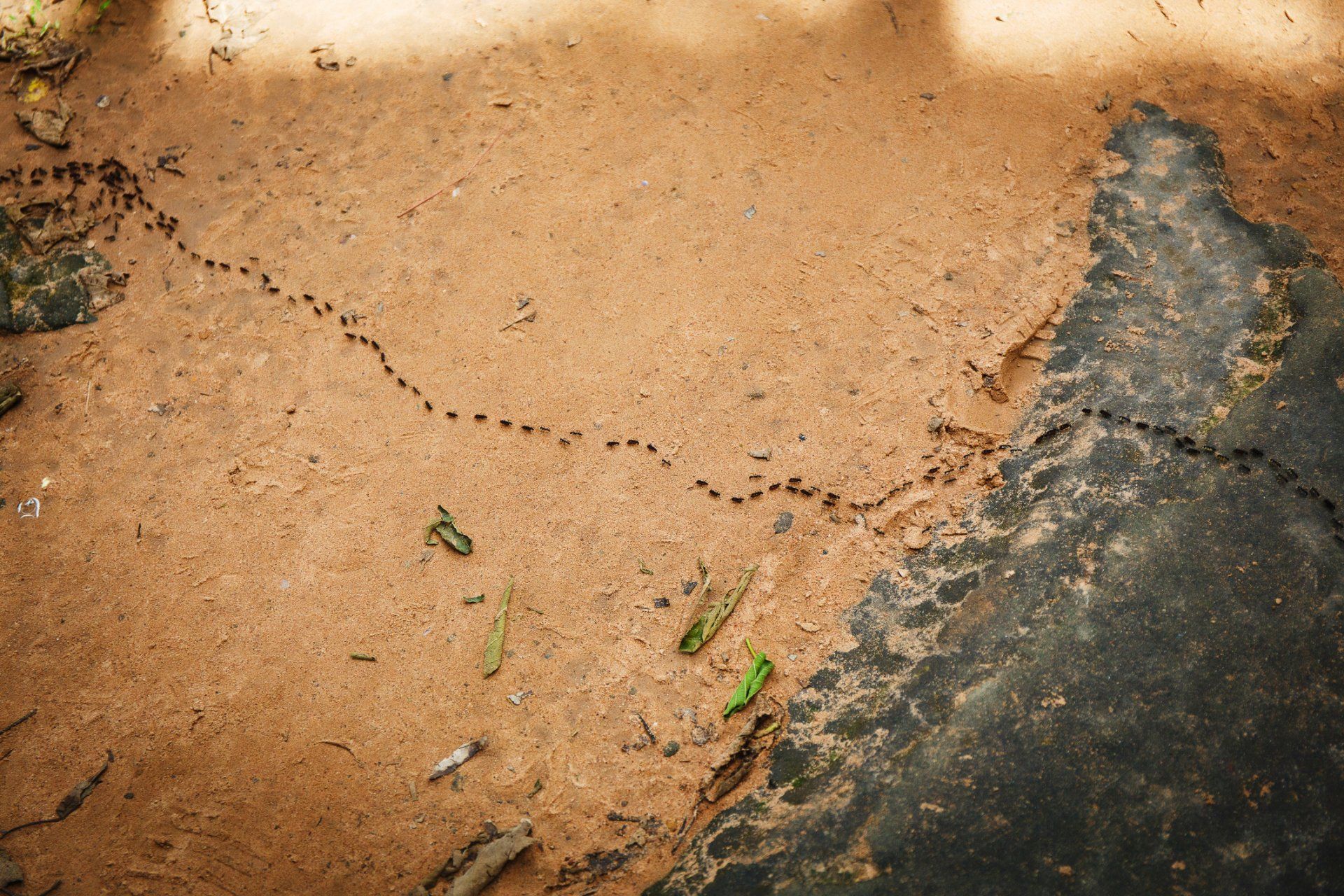Ants
Ants are a very common problem in this area and may be difficult to control. After the first treatment it is common to see "new" colonies appearing from other places in the house. This happens because ants communicate with each other through sound, touch and pheromones.
A crushed ant emits an alarm pheromone that sends nearby ants into an attack frenzy and attracts more ants from farther away. Several ant species even use "propaganda pheromones" to confuse enemy ants and make them fight among themselves.
Pheromones also are exchanged, mixed with food, transferring information within the colony. This allows other ants to detect what task group (e.g., foraging or nest maintenance) to which other colony members belong.
Over the counter products don't usually work for ants because they are simply not strong enough. They also only kill ants that you see, not the entire colony. Over the counter products may even worsen the problem with time, because they cause resistance. Resistance doesn't mean that the ants get stronger but it means that the colony gets stronger and resistant to the product. Resistance happens because the weak ants die and strong ones stay alive and reproduce, so soon you will have an entire colony completely resistant to the product.
It is important to address the problem as quickly as possible, because the infestation can worsen severally over time and cause great damage to your property, specially if you are dealing with carpenter ants. Carpenter Ants can cause just as much damage as termites.
What to do?
The product that we use is very effective against ants. It is a prescription product, which means that only licensed pest control technicians can buy or apply it. But it is still safe for your family, children and pets when applied by a certified and experienced technician.
Our chemical doesn't kill the ants right away, rather creates a sort of "ant infection" that is carried back to the colony. Soon the entire colony dies, not only one. Even if only one ant gets in contact with this product, it will still be enough to exterminate the entire colony.
It is important to maintain the treatment in a regular basis until all colonies are gone.
Ants can get inside our homes through very small cracks. Sometimes an exclusion should be advised to avoid new colonies from coming in seeking water, sweets or greasy items in the kitchen pantry or storeroom areas.
We have monthly, quarterly
and yearly agreements available upon request at a discounted price from a one-time treatment. This way it's easy and inexpensive to maintain your home ants-free.
Call now (775) 425-4343
or email us at statewidepest@sbcglobal.net
Ants As Pests
(Source: WIKIPEDIA.ORG)
The tiny pharaoh ant is a major pest in hospitals and office blocks; it can make nests between sheets of paper
Some ant species are considered pests,[10] and because of the adaptive nature of ant colonies, eliminating the entire colony is nearly impossible. Therefore pest management is a matter of controlling local populations, instead of eliminating an entire colony, and most attempts at control are temporary solutions.
Ants classified as pests include the pavement ant, yellow crazy ant, sugar ants, the Pharaoh ant, carpenter ants, Argentine ant, odorous house ants, red imported fire ant, and European fire ant.
Populations are controlled using insecticide baits, either in granule or liquid formulations. Bait is gathered by the ants as food and brought back to the nest where the poison is inadvertently spread to other colony members through trophallaxis.
Carpenter Ants
(Source: WIKIPEDIA.ORG)
Carpenter ants are large (.25 to 1 in/0.64 to 2.5 cm) ants indigenous to many parts of the world. They prefer dead, damp wood in which to build nests. They do not eat it, however, unlike termites.[1] Sometimes carpenter ants will hollow out sections of trees. The most likely species to be infesting a house in the United States is the black carpenter ant (Camponotus pennsylvanicus). However, there are over a thousand other species in the genus Camponotus.
Carpenter ant species reside both outdoors and indoors in moist, decaying or hollow wood. They cut "galleries" into the wood grain to provide passageways for movement from section to section of the nest. Certain parts of a house, such as around and under windows, roof eaves, decks and porches, are more likely to be infested by Carpenter Ants because these areas are most vulnerable to moisture.
As pests
Carpenter ants can damage wood used in the construction of buildings. They can leave behind a sawdust-like material called frass that provides clues to their nesting location. Carpenter ant galleries are smooth and very different from termite-damaged areas, which have mud packed into the hollowed-out areas
STATEWIDE Termite & Pest Control, Inc.
No obligations!
Contracts upon request. Cancel Anytime!
BROWSE OUR WEBSITE
CONTACT INFORMATION
Office: (775) 425-4343Email: statewidepest@sbcglobal.net
Address: Reno, NV
Mail to: 1894 E William St., Suite 4 #494, Carson City, NV 89701-3202
Content, including images, displayed on this website is protected by copyright laws. Downloading, republication, retransmission or reproduction of content on this website is strictly prohibited. Terms of Use
| Privacy Policy




